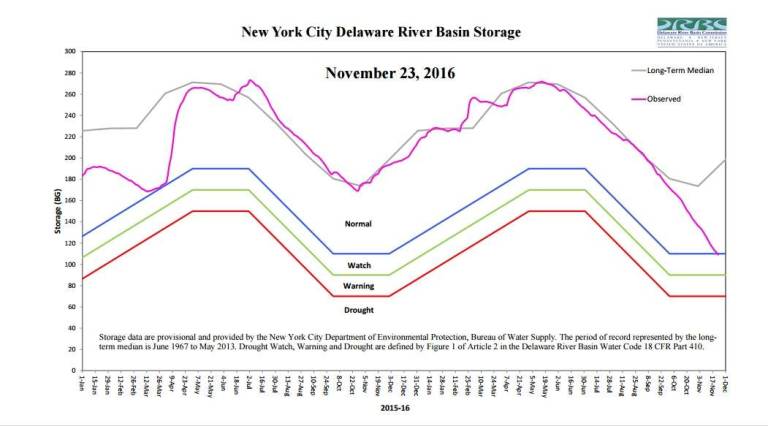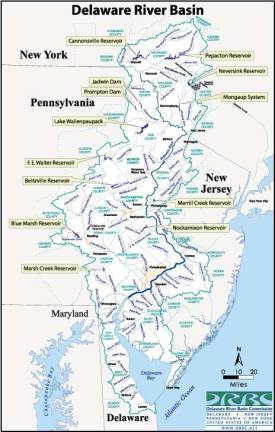Drought Watch declared in Delaware Basin


MONTAGUE, N.J. — A call for conservation in the Delaware River basin comes water levels in three reservoirs at the headwaters of the Delaware River have plunged to about 40 percent of capacity.
At a special meeting on Nov. 23, the Delaware River Basin Commission declared a drought watch in response to "persistently dry conditions." It has issued a special permit for coordination among reservoirs, out-of-basin diversions, and river flow objectives.
Below-normal precipitation throughout most of the basin has affected streams, groundwater, reservoirs, and soil moisture, the commission says.
Under the special permit, the transition from one drought stage to another — from “watch” to “warning” to “drought” and back again to “normal” — will be based on storage in the three Catskill reservoirs — Cannonsville, Pepacton, and Neversink in New York State — which supply New York City with about half of its water. The reservoirs also support a minimum flow target in the Delaware River at Montague, N.J., as established by the U.S. Supreme Court Decree of 1954. Parties to the decree include Delaware, New Jersey, Pennsylvania, New York State, and New York City.
Protecting taps from salty waterThe river flow objective at Montague and a second flow objective at Trenton, N.J. will also be reduced, depending on the location of the “salt line” in the estuary. Freshwater is needed to keep “salty” or “brackish” water out of drinking water in Philadelphia and New Jersey.
“As of Nov. 20, the salt front is 19 river miles upstream from its normal location for the month despite significant freshwater reservoir releases,” said Steve Tambini, executive director of the Delaware River Basin Commission (DRBC). “The current salt front location is still 21 miles downstream of water supply intakes in Pennsylvania and New Jersey.”
Under the “drought watch,” some reservoirs may be asked either to store or release water. Releases may be required from Merrill Creek Reservoir in Warren County, N.J., built by a consortium of electric utilities to replace losses to evaporation caused by power generation.
Out-of-basin diversions to New York City and portions of New Jersey will be reduced. A reserve “bank” of water built up over the past year will be available, allowing New Jersey to minimize the effects of possible reductions.
The DRBC is urging all water users to curb water use and maximize water efficiency wherever possible.
“Over 15 million people rely on waters of the Delaware River Basin,” said Tambini.
For more information, visit drbc.net.